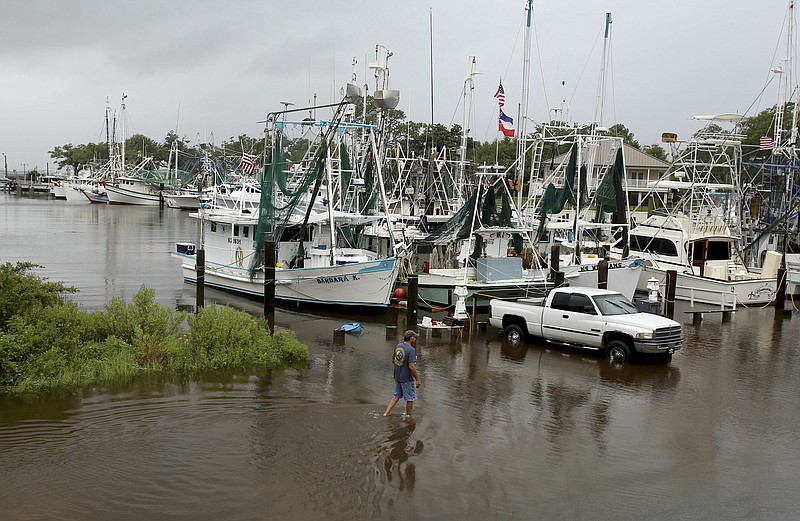NEW ORLEANS - Tropical Storm Cindy sent drenching rain bands over the north Gulf Coast on Wednesday, swamping low-lying coastal roads and pushing a waterspout ashore in one beachfront community as residents from east Texas to the Florida Panhandle warily eyed the storm's slow crawl toward land.
Louisiana Gov. John Bel Edwards, like his Alabama counterpart a day earlier, declared a state of emergency Wednesday as dangerous flash-flooding remained a threat.
Cindy had weakened slightly, with top sustained winds dropping to 50 mph (85 kph) from 60 mph (95 kph) earlier, but heavy rain bands spinning off the storm remained the biggest threat to coastal residents across parts of five states. A tropical storm warning was in effect along the coast from San Luis Pass, Texas, to the mouth of the Mississippi River.
On the Mississippi coast, a waterspout came ashore in Biloxi even as heavy rains slackened early Wednesday. Harrison County Emergency Management Director Rupert Lacy said there were no injuries but fences, trees and power lines were damaged
"There's still a long stretch of tropical moisture coming across the Gulf of Mexico," said Alek Krautmann of the National Weather Service in Slidell, Louisiana. "We still think there's a heavy rain potential really through Thursday night and early Friday."
By Wednesday morning, the storm had dumped from 2 to 7 inches (50-180 millimeters) of rain on parts of southern Louisiana. In coastal Mississippi, some areas received 6 to 9 inches (150-230 millimeters). Bands of dry air pulled into the storm from the northwest helped spread out the rain bands, Krautmann said, somewhat easing the danger of flooding overnight.
Still, there were widespread reports of street and road flooding along the Gulf Coast as far east as Florida, where the National Park Service reported the bridge between Navarre Beach and Pensacola Beach was closed. One emergency official also reported downed trees and other damage in and around Fort Walton Beach in the Florida Panhandle after a storm cell blew through.
"We were saturated before this even started ... I'm a bit concerned about what the next 24 hours will bring," real estate broker John Rickman in Pensacola said.
In Alabama, streets were flooded and beaches were closed on the barrier island of Dauphin Island. Some roads were covered with water in the seafood village of Bayou La Batre, but Becca Caldemeyer still managed to get to her bait shop at the city dock. If only there were more customers, she said.
"It's pretty quiet," Caldemeyer said by phone from Rough Water Bait and Tackle. "Nobody can cast a shrimp out in this kind of wind."
Alabama Gov. Kay Ivey issued a state of emergency Tuesday because of the threat of torrential rains, dangerous high tides and rip currents.
The third tropical storm of 2017, Cindy was 170 miles (270 kilometers) south-southwest of Morgan City, Louisiana as of mid-morning Wednesday.
Forecasters expected rain totals of 6 to 9 inches (150-220 millimeters), with up to 12 inches (300 millimeters) in some spots in Louisiana, Alabama, Mississippi and the Florida Panhandle. East Texas rain totals were expected to reach anywhere from 3 to 6 inches (80-150 millimeters).
Texas Gov. Greg Abbott ordered the State Operations Center on Tuesday to raise its readiness level from level four/normal conditions to level three/increased readiness. He also activated four Texas Task Force 1 boat squads and two Texas Military Department vehicles squads of five vehicles each to respond to any weather-related emergencies.
Workers on Grand Isle, Louisiana's barrier island community south of New Orleans, worked to reinforce a rock levee protecting the island's vulnerable west side.
The Louisiana National Guard dispatched high water vehicles and helicopters into flood-prone areas. The state said the Federal Emergency Management Agency was moving 125,000 meals and 200,000 liters of water into Louisiana.
"All arms of the state's emergency preparedness and response apparatus are taking Tropical Storm Cindy seriously, and we are calling on all Louisianans throughout the state to do so as well," Louisiana Gov. John Bel Edwards said in a statement early Wednesday.
On Tuesday, flood control locks and gates were closed along Louisiana's bayou-marbled coast. And authorities in various coastal Louisiana and Mississippi communities handed out sandbags for areas along rivers and bayous.
In coastal Louisiana's Terrebonne Parish, Kim Chauvin said the shrimp processing businesses she and her husband run helped put out the word this week that shrimpers should return to port and unload their catch before flood control structures closed.
"We call them, we text them, we Facebook them, we Twitter, them. Any way we can get to them," she said.
